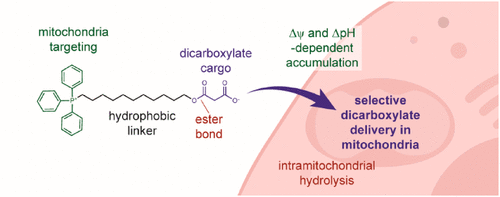当前位置:
X-MOL 学术
›
Mol. Pharmaceutics
›
论文详情
Our official English website, www.x-mol.net, welcomes your feedback! (Note: you will need to create a separate account there.)
Selective Delivery of Dicarboxylates to Mitochondria by Conjugation to a Lipophilic Cation via a Cleavable Linker.
Molecular Pharmaceutics ( IF 4.9 ) Pub Date : 2020-07-21 , DOI: 10.1021/acs.molpharmaceut.0c00533 Hiran A Prag 1 , Duvaraka Kula-Alwar 2 , Laura Pala 3 , Stuart T Caldwell 3 , Timothy E Beach 4 , Andrew M James 1 , Kourosh Saeb-Parsy 4 , Thomas Krieg 2 , Richard C Hartley 3 , Michael P Murphy 1, 2
Molecular Pharmaceutics ( IF 4.9 ) Pub Date : 2020-07-21 , DOI: 10.1021/acs.molpharmaceut.0c00533 Hiran A Prag 1 , Duvaraka Kula-Alwar 2 , Laura Pala 3 , Stuart T Caldwell 3 , Timothy E Beach 4 , Andrew M James 1 , Kourosh Saeb-Parsy 4 , Thomas Krieg 2 , Richard C Hartley 3 , Michael P Murphy 1, 2
Affiliation

|
Many mitochondrial metabolites and bioactive molecules contain two carboxylic acid moieties that make them unable to cross biological membranes. Hence, there is considerable interest in facilitating the uptake of these molecules into cells and mitochondria to modify or report on their function. Conjugation to the triphenylphosphonium (TPP) lipophilic cation is widely used to deliver molecules selectively to mitochondria in response to the membrane potential. However, permanent attachment to the cation can disrupt the biological function of small dicarboxylates. Here, we have developed a strategy using TPP to release dicarboxylates selectively within mitochondria. For this, the dicarboxylate is attached to a TPP compound via a single ester bond, which is then cleaved by intramitochondrial esterase activity, releasing the dicarboxylate within the organelle. Leaving the second carboxylic acid free also means mitochondrial uptake is dependent on the pH gradient across the inner membrane. To assess this strategy, we synthesized a range of TPP monoesters of the model dicarboxylate, malonate. We then tested their mitochondrial accumulation and ability to deliver malonate to isolated mitochondria and to cells, in vitro and in vivo. A TPP–malonate monoester compound, TPP11–malonate, in which the dicarboxylate group was attached to the TPP compound via a hydrophobic undecyl link, was most effective at releasing malonate within mitochondria in cells and in vivo. Therefore, we have developed a TPP–monoester platform that enables the selective release of bioactive dicarboxylates within mitochondria.
中文翻译:

通过经由可裂解的接头缀合至亲脂性阳离子,将二羧酸盐选择性递送至线粒体。
许多线粒体代谢物和生物活性分子包含两个羧酸部分,这使它们无法穿过生物膜。因此,在促进将这些分子摄取到细胞和线粒体中以修饰或报告其功能方面引起了相当大的兴趣。与三苯基phosph(TPP)亲脂性阳离子的结合被广泛用于响应膜电位将分子选择性地递送至线粒体。但是,永久附着在阳离子上会破坏小二羧酸盐的生物学功能。在这里,我们已经开发出一种使用TPP在线粒体内选择性释放二羧酸盐的策略。为此,二羧酸盐通过单酯键连接到TPP化合物,然后通过线粒体内的酯酶活性进行切割,在细胞器内释放二羧酸盐。保留第二种羧酸也意味着线粒体的吸收取决于内膜上的pH梯度。为了评估该策略,我们合成了模型二羧酸酯,丙二酸酯的一系列TPP单酯。然后,我们测试了它们的线粒体积累和将丙二酸递送至分离的线粒体和细胞的能力,体外和体内。一种TPP-丙二酸酯单酯化合物TPP 11-丙二酸酯,其中二羧酸酯基通过疏水性十一烷基键连接到TPP化合物上,最有效地在细胞和体内线粒体内释放丙二酸酯。因此,我们开发了一种TPP-单酯平台,可在线粒体内选择性释放生物活性二羧酸盐。
更新日期:2020-09-09
中文翻译:

通过经由可裂解的接头缀合至亲脂性阳离子,将二羧酸盐选择性递送至线粒体。
许多线粒体代谢物和生物活性分子包含两个羧酸部分,这使它们无法穿过生物膜。因此,在促进将这些分子摄取到细胞和线粒体中以修饰或报告其功能方面引起了相当大的兴趣。与三苯基phosph(TPP)亲脂性阳离子的结合被广泛用于响应膜电位将分子选择性地递送至线粒体。但是,永久附着在阳离子上会破坏小二羧酸盐的生物学功能。在这里,我们已经开发出一种使用TPP在线粒体内选择性释放二羧酸盐的策略。为此,二羧酸盐通过单酯键连接到TPP化合物,然后通过线粒体内的酯酶活性进行切割,在细胞器内释放二羧酸盐。保留第二种羧酸也意味着线粒体的吸收取决于内膜上的pH梯度。为了评估该策略,我们合成了模型二羧酸酯,丙二酸酯的一系列TPP单酯。然后,我们测试了它们的线粒体积累和将丙二酸递送至分离的线粒体和细胞的能力,体外和体内。一种TPP-丙二酸酯单酯化合物TPP 11-丙二酸酯,其中二羧酸酯基通过疏水性十一烷基键连接到TPP化合物上,最有效地在细胞和体内线粒体内释放丙二酸酯。因此,我们开发了一种TPP-单酯平台,可在线粒体内选择性释放生物活性二羧酸盐。


























 京公网安备 11010802027423号
京公网安备 11010802027423号